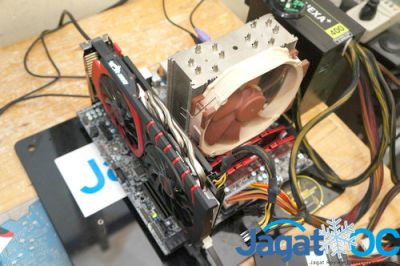JagatOC Confirms Skylake non-K BCLK Overclocking on C7H170-M: Core i3 6100 at 4.5GHz

Four days ago we wrote about the overclocking antics of Dhenzjhen who managed to overclock the locked Core i3 6320 Skylake processor via the base clock frequency. The overclocking world was stunned as Intel has restricted BCLK overclocking on mainstream platforms since Sandy Bridge. Overclocking is typically reserved to Z-chipsets and -K processors. In article published yesterday by JagatOC, we find the overclocking capabilities confirmed.
In an article published by the Indonesian hardware website Jagatoc.com, Alva Jonathan confirms the BCLK overclocking capabilities of the Supermicro motherboard. One of the features of the C7H170-M motherboard is the so-called SuperMicro Superjet Technology, a (silly) marketing term for the overclocking function. The article covers a great deal of information and details on the motherboard, but we're more interested in the overclocking stuff.
In the overclocking settings menu in the BIOS, there's an option called BCLK Clock Frequency which allows base clock overclocking in intervals of 5 MHz up to 145MHz. That's 45%. The memory frequency is configurable up to DDR4-3200. For the Core i3 6100 processor used for the article, that means an easy 4GHz overclock with a modest 115MHz BCLK. The performance increase is pretty interesting. The benchmark scores increase 12-15% as expected and in a game like Watch Dogs you can see a healthy increase in FPS. With the GeForce GTX 960, JagatOC notes an increase from 58 to 67 in average FPS.
The question is of course - is this for real. To be frank, we spent a great deal communicating with the various motherboard vendors in Taiwan trying to replicate the BCLK overclocking and sync'd information with the overclocking team at Intel. Honestly, the results from Dhenzjhen surprised everyone. The article from JagatOC certainly brings supporting evidence of "this is for real" and it will be interesting to see if other motherboard vendors will bring similar features to their motherboard SKUs. What exactly is allowing the overclocking is still not really clear. Is this related to the H-chipsets SuperMicro received? Maybe BIOS or microcode related? Several indications point to software or firmware.
What makes it all more interesting is that XTU fails to run properly with BCLK overclocking enabled and software monitoring applications like HWInfo and Core Temp as well as XTU display incorrect temperature information (+100 degrees centigrade).
To be continued ...





Please log in or register to comment.